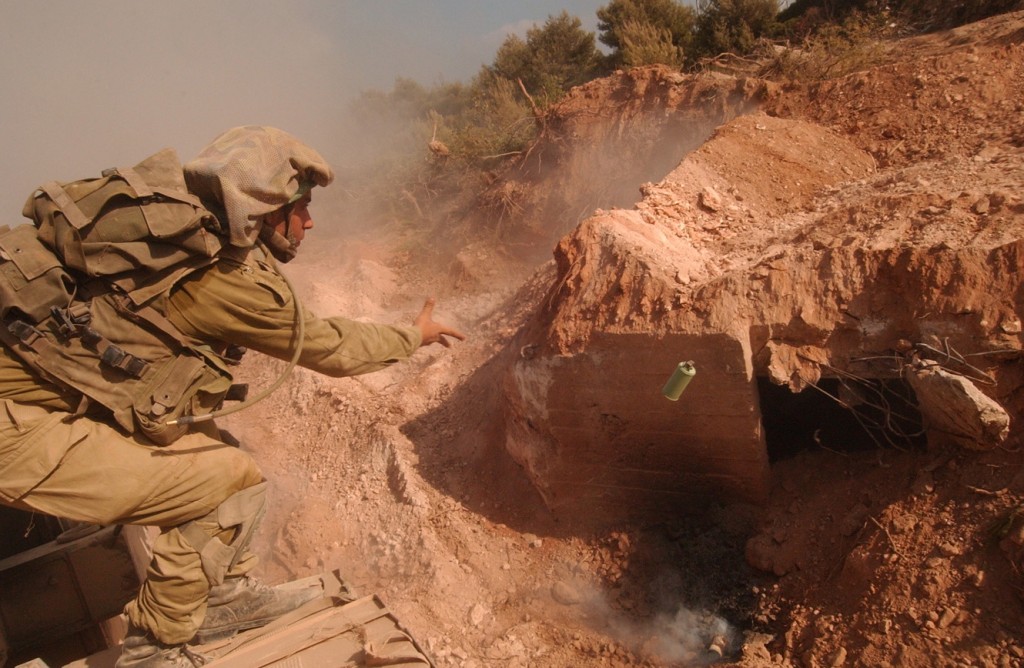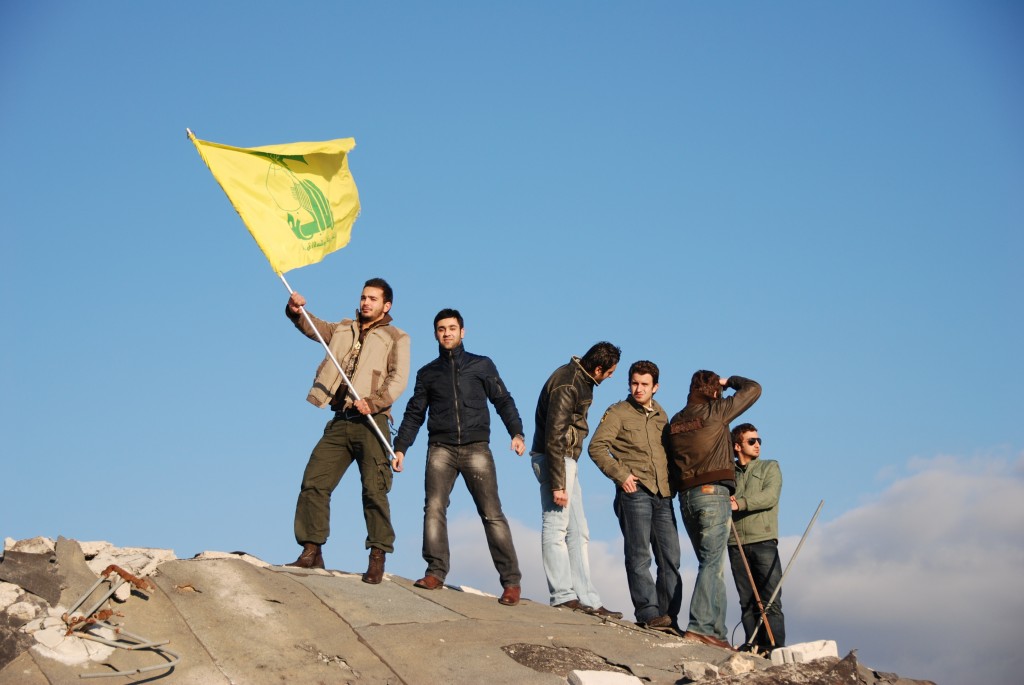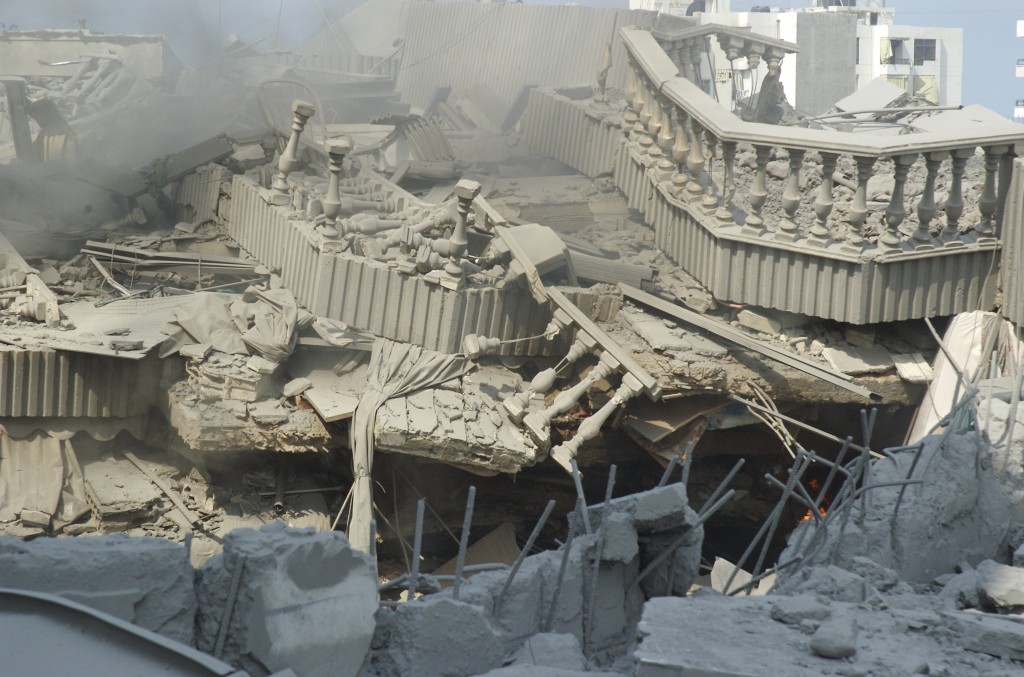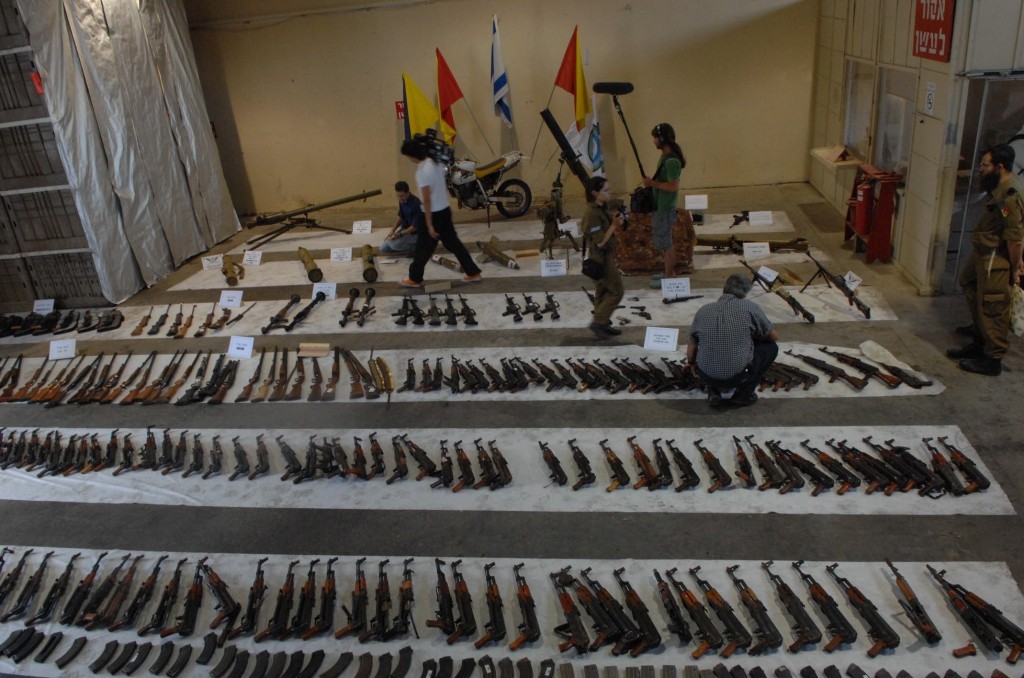Hezbollah has learned much in the ten years since it last fought Israel. The next war will likely be even more devastating.
Hezbollah remains the one Arab force to have denied the IDF a single decisive victory in the past three decades. It has done so by operating as a guerrilla force. However, pundits are now suggesting that when the Iranian proxy group initiates its next war with Israel, it will employ the conventional military experience it has gained in the Syrian Civil War, thus presenting a challenge to the Jewish state. Mistakenly, they ignore that Hezbollah would be exposing itself by operating as a conventional force, facilitating the IDF’s victory. Instead the group will revert to operating as a guerrilla organization, leaving Lebanon and its civilians to bear the brunt of the Israeli onslaught.
Hezbollah has been conducting itself as a regular army since the escalation of its role in the Syrian Civil War in 2013. Following the battle of Qusayr, Hezbollah has moved from insurgency to counterinsurgency. It has been fighting openly along established front lines in order to conquer and control territory so as to weaken and destroy its opponents. Its fighters have even acted as battlefield commanders of Syrian troops. Hezbollah’s weaponry in Syria also reflects a more conventional strategy. The group has operated Syrian tanks and artillery systems, jeeps with recoilless rifles, and is even rumored to have acquired its own 75-tank armored brigade.
Although Hezbollah has grown considerably stronger since the 2006 Second Lebanon War with Israel, it is far from closing the power gap with the IDF. Notwithstanding its bellicose propaganda, Hezbollah’s leadership recognizes the IDF’s continued military superiority. The group’s leader, Hassan Nasrallah, readily acknowledges that Israel is a “real power” to be reckoned with, and his deputy Naim Qassem has admitted that Hezbollah never envisioned fighting the Jewish state in “a classic war,” because it lacked the “sufficient numbers, equipment, and military capabilities” a conventional army enjoys. For their part, the Israelis have made it clear that their intentions are to exploit this “total asymmetry” to their advantage in the next war. They will aim to hit the group “in the most muscular way possible” and score the decisive victory that has eluded them in the past. Per what is called the Gideon Doctrine, Israel intends to quickly unleash its full force against Hezbollah, throwing it off-balance and dealing it a crushing blow before it can recover.
Instead of aiming to “erode” Hezbollah forces with overwhelming standoff firepower, the IDF will now give priority to a rapid deployment of ground forces, simultaneous with immediate and integrated aerial, naval, artillery, and cyber-attacks. As part of this new strategy, the IDF will not aimlessly hunt Hezbollah’s Katyusha rockets with air power, as it did in 2006. Instead, it will seek to penetrate the group’s territory quickly in order to damage its political and military infrastructure, while simultaneously deploying massive force against Hezbollah targets.
This is a very different strategy than the one employed in 2006, but it is by no means unprecedented.
Israel’s 1982 invasion of southern Lebanon in order to demolish the Palestine Liberation Organization provides an (imperfect) example of a war against a terror group that had transformed into a regular army. During the Lebanese civil war, the PLO engaged in a misguided conventional build-up, establishing a full-time, semi-regular, and visible force that fielded heavy weaponry, artillery, and armor meant to defend and hold territory. So long as Israel did not launch a war, this force proved effective in harassing Israel’s northern communities, much like Hezbollah’s Katyusha rockets did later on. There was, however, one fatal flaw in this strategy: PLO forces lacked the mobility Hezbollah would demonstrate in subsequent decades.
Israel’s invasion operated much like the Gideon Doctrine envisions a future conflict against Hezbollah: Coupling heavy aerial and artillery bombardment with a massive combined-arms ground attack. Against this, regular Palestinian forces performed dismally and were quickly decimated. IDF confrontations with PLO tank units, reinforced by mobilized infantry, ended quickly in the Israelis’ favor. Though the PLO fought with determination, it was virtually destroyed.
By contrast, Palestinian irregulars fought the IDF with relative success in urban combat in the south Lebanon cities of Tyre and Sidon and their surrounding refugee camps, where the Israeli advance was much slower. In Ein al-Hilweh, the largest Palestinian refugee camp in Lebanon, the irregulars pinned down a Golani Brigade battalion commanded by one of Israel’s most storied brigadier generals, Avigdor Kahalani, forcing it to fight its way out of the camp at dusk. An even-larger Israeli force sent in the next day also failed to penetrate the camp. Urban fighting once again proved effective against Israel’s summer 1982 siege of Beirut. In the end, the PLO received the smallest returns from its conventional build-up, and the most from its guerrilla fighters in the refugee camps.
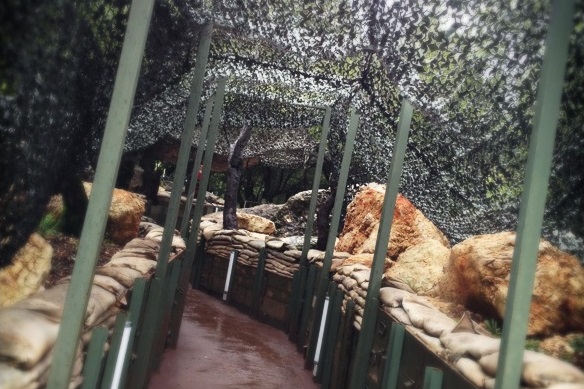
The Tourist Landmark of the Resistance is a Hezbollah museum in Mleeta, Lebanon. Photo: Helga Tawil Souri / flickr
Hezbollah likely learned a lesson from the PLO’s confrontation with the IDF, and has redefined victory in psychological terms in order to suit its limited capabilities. Often, this concept disregarded actual battlefield results. In contrast to its behavior in Syria, Hezbollah never aimed to decisively defeat the IDF, seize and hold Israeli-controlled territory (even within Lebanon), or “liberate Palestine.”
Having set a much lower bar, Hezbollah could claim victory by simply maintaining its ability to survive and continue fighting. “As long as there is a missile that is fired from Lebanon and targets the Zionists, as long as there is one fighter who fires his rifle, as long as there is someone who plants a bomb against the Israelis,” Nasrallah has said, “this means the resistance still exists.” Thus, a stalemate with the IDF would represent a “victory” for the group, whereas the Israelis would view it as a defeat.
Hezbollah’s first confrontation with Israel occurred during the Jewish state’s 15-year occupation of southern Lebanon. During that time, the group developed a thirteen-point guerrilla doctrine tailored to its conception of “victory” and designed to defeat the relatively fixed, technologically advanced, and militarily superior IDF. It focused on such principles of guerrilla warfare as surprise, identifying and hitting Israeli weak points, slipping away “like smoke” before the IDF could respond, and gradually wearing down the enemy. As with most guerrilla campaigns, Hezbollah’s goal was to weaken Israel’s will to fight, increasing its adversary’s losses, and denying it the ability to destroy the organization. Hezbollah’s methods were intended to shorten the overall timespan during which Israel could unleash its full military force against the group and minimize the damage it would take during that time.
Realizing that the IDF could not destroy what it could not see, Hezbollah attempted to deny Israeli pilots and artillery visible targets. The group took full advantage of Lebanon’s rocky terrain to do so, and kept its training camps camouflaged and mobile. Hezbollah recognized the superiority of Israeli gunners, and knew that if it were to acquire its own tanks and fixed artillery, they would prove easy targets for the Israel Air Force (IAF). As a result, it opted for small arms, giving it battlefield flexibility and minimizing its fighters’ exposure to the IDF. On the battlefield, it kept its forces dispersed. By having them act as autonomous and secret cells, Hezbollah obviated the need for static supply and communication lines that could easily be cut by the Israelis.
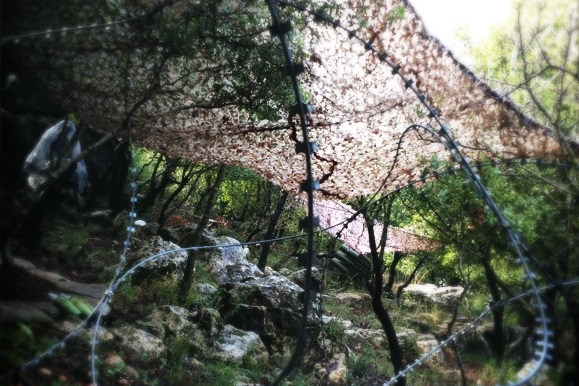
The Tourist Landmark of the Resistance is a Hezbollah museum in Mleeta, Lebanon. Photo: Helga Tawil Souri / flickr
Per Hezbollah’s doctrine, it also scrupulously avoided engaging the IDF in set-piece battles, which the group viewed as a futile show of force. Instead, it opted to attack and immediately slip away. This confined the IDF to passive defense, making its troops easier targets. Over time, Hezbollah launched increasingly elaborate attacks on Israeli outposts and those of Israel’s allies in the South Lebanon Army. However, these attacks lasted only a few minutes, with the guerrillas escaping the area as the IDF’s artillery and helicopters struck at suspected exfiltration routes in vain. Hezbollah thus denied the Israelis the ability to respond to attacks, making them look incompetent. When Prime Minister Yitzhak Rabin came under pressure in 1994 to deal a crippling blow to Hezbollah, he responded in exasperation, “There are no targets to retaliate against!”
In frustration at Hezbollah’s successes, Israel lashed out against the group twice—in 1993’s Operation Accountability and 1996’s Operation Grapes of Wrath—with overwhelming air and artillery power. Though these operations wrought considerable damage on Lebanon, they barely harmed the organization. For its part, Hezbollah’s elusiveness ensured that Israel made no battlefield gains, and it continued to fire Katyusha rockets until a ceasefire went into effect. The high number of Lebanese civilian casualties in these operations, moreover, succeeded in making the IDF appear not just ineffective but cruel.
Civilian cover was another aspect of Hezbollah’s target-denial method. During the south Lebanon conflict, Hezbollah constrained the IDF with “rules of the game” that limited Israel’s ability to use its massive artillery and aerial power in response to Hezbollah attacks from civilian areas. An IDF response to these attacks carried the inherent risk of civilian casualties, inevitably leading to international pressure on Israel to prematurely halt its military actions. Moreover, civilian deaths allowed Hezbollah to turn Lebanese hearts and minds against the Israelis. Its charities would rebuild demolished homes and take care of survivors, using the ensuing sympathy to gain new recruits. As Hezbollah’s doctrine reads, “The population is a treasure—nurture it!”
Hezbollah also began developing a “rocket doctrine” that raised the cost of striking its civilian surroundings. Whenever the IDF’s responses killed Lebanese citizens, Hezbollah fired massive Katyusha barrages at Israel’s own civilians. While the Israeli home front is not the vulnerable “spider web” of Nasrallah’s imagination, it was also unwilling to pay the price for a war in which the military made no gains.
When Israel held its fire, Hezbollah could operate with impunity in civilian areas. This allowed Hezbollah to enlarge and deepen its operational, logistic, and intelligence network, which in turn made it even harder for the IDF to target the group’s units and infrastructure. It also negated or lowered the cost Lebanese civilians would have to pay for supporting the organization.
Israel found neither option acceptable, and instead employed smaller, more mobile ground patrols to pursue Hezbollah. But by reducing the effectiveness of Israeli armor, artillery, and airpower, Hezbollah was able to expose Israel’s ground troops to attack. And because Hezbollah’s first principle of warfare is “avoid the strong, attack the weak,” it went after the IDF’s ground troops—who never numbered more than 3,000—with roadside bombs and lethal ambushes. Qassem has said that Hezbollah wanted to confuse the Israeli invaders and force the IDF command into a constant state of alert, which would “eventually” exhaust the army. The group sought to spread panic among IDF soldiers and “shake enemy morale and subsequently [affect] troop performance.” Hezbollah aimed to score “thousands of small victories” that would slowly bleed the enemy and erode its will to fight—ultimately leading to its withdrawal from southern Lebanon.
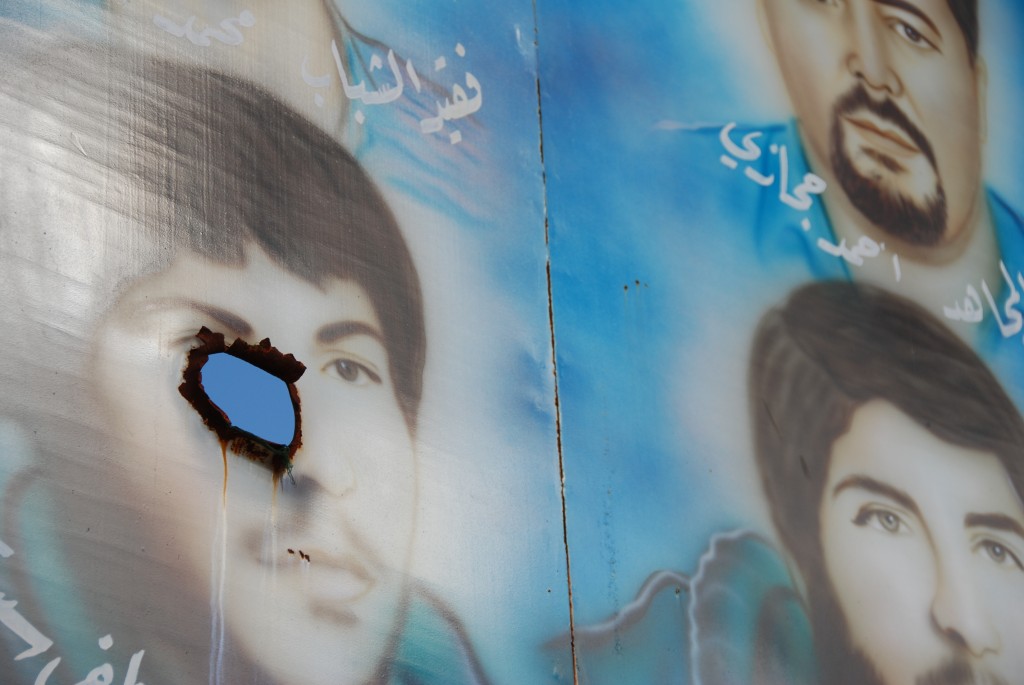
Shell hole in the portrait of a dead Hezbollah fighter painted on a signboard along the road from Tyre to Bint Jbeil in southern Lebanon. Photo: Paul Keller / flickr
In this way, Hezbollah bogged Israel down in a war of attrition. Former government spokesman Uri Dromi called this Israel’s “worst nightmare,” because it deprived the military of its main assets—mobility and striking power—and exploited the country’s reluctance to suffer casualties in a protracted war. In purely military terms, the reality on the ground—and the body count—was always in Israel’s favor, but what Hezbollah grasped early on, which the Israelis never did, was that in a war against a guerrrilla group, perception can matter more than actual military results. In his memoir, Qassem wrote that psychological warfare has compensated for Hezbollah’s inability to conquer territory or to attain a decisive victory in the way a conventional army can do.
In line with this, Hezbollah’s doctrine demands that attacks only be carried out “when success is assured.” Though it is far less casualty-averse than the IDF, Hezbollah emphasized force protection, making sure it did not sacrifice its fighters in unwinnable battles. In fact, contrary to the martyrdom-seeking image it has cultivated, Hezbollah’s operations were not suicidal, but aimed to inflict maximum losses on the Israelis while suffering the fewest possible losses of its own. Unlike a conventional army, however, Hezbollah’s goal was not to win battles, but to maximize the psychological effect of its attacks on IDF soldiers and the Israeli people.
The group also masterfully exploited the media to amplify the effect of Israel’s losses, giving the impression that it was making real gains against the IDF. It strove to ensure that a steady trickle of IDF casualties appeared on Israel’s evening news. “The media has innumerable guns whose hits are like bullets,” reads its doctrine. “Use them in battle.” A prominent example of this took place in 1994, when Hezbollah guerrillas stormed the IDF’s Pumpkin Outpost in south Lebanon. Hezbollah released a film showing its fighters firing at the outpost’s defenders and planting their flag before the video abruptly cut away. Hezbollah propaganda claimed it had captured the hill and “purified it of the Zionists.” In fact, only one IDF soldier was killed and the outpost remained intact.

The Tourist Landmark of the Resistance is a Hezbollah museum in Mleeta, Lebanon. Photo: Helga Tawil Souri / flickr
This relatively minor incident—a Hezbollah attack repulsed by the garrison’s defenders—was perceived as a major military defeat in Israel, with some analysts going so far as to declare that the army’s “fighting spirit has been broken.” Hezbollah repeated this in a 1999 attack that killed Brig. Gen. Erez Gerstein, Israel’s highest-ranking officer in Lebanon. Gerstein’s death did not throw Israeli forces into disarray or lead to the collapse of its security zone. But the fact that Hezbollah could reach such a senior IDF officer made it another significant “psychological defeat” for the Israelis.
Hezbollah thus repeatedly snatched victory from the jaws of defeat. It exposed a raw nerve in Israeli society—its sensitivity to casualties—and exploited it relentlessly. Hezbollah gradually eroded Israeli tolerance for a war in which its sons were increasingly seen as dying for nothing. Over time, this perception fueled pressure on the government to withdraw from Lebanon, and on May 25, 2000, Israel did just that. That day marked Hezbollah’s greatest victory yet.
During the 2006 Second Lebanon War, circumstances that contributed to the success of Hezbollah’s guerrilla strategy had changed. Israel no longer maintained the bases or fixed positions in southern Lebanon that had proved easy targets for Hezbollah. Moreover, the IDF was no longer constrained by the old “rules of the game” that gave Hezbollah immunity in civilian areas. Its new doctrine entailed the use of massive aerial and artillery firepower on sources of Hezbollah fire or weapons stores, wherever they were located. During the war, the Israel Air Force struck at Hezbollah headquarters and command facilities, attempted to attack deployed enemy forces directly, and bombed Lebanese infrastructure to force the country’s government to pressure Hezbollah into returning kidnapped soldiers and withdrawing from the area adjoining the border.
However, IDF planning remained shaped by the country’s sensitivity to casualties, making the leadership hesitant to push forward, knowing it would cost significantly more lives. One IDF general has said that every single casualty was reported to the IDF Chief of Staff and, in one case, an entire battle was stopped because of one casualty. As a result, Israel again resorted to its old, ineffective methods—simultaneously inflicting pain with aerial and artillery bombardment, and restraining itself by not committing the ground troops necessary for victory, opting instead for limited incursions. Israel’s effort to spare the lives of its soldiers—however understandable—inadvertently left its civilians exposed to Hezbollah rocket fire.
Hezbollah once again exploited this weakness, and as IAF strategist Ron Tira noted in a paper for Israel’s Institute for National Security Studies, the group did not fundamentally alter its earlier strategy, since much of its doctrine remained effective. It continued to force Israel to choose between equally undesirable options: Avoiding a ground operation and imperiling its home front, or entering Lebanon and sustaining potentially heavy casualties in a drawn-out war of attrition.

A sculpture on the outskirts of Bint Jbeil depicts rockets aimed towards Israel. Photo: Paul Keller / flickr
Hezbollah once again denied the IAF and IDF targets for their precision weapons. Tactically, it emphasized light weapons and transportation with a low radar signature—even using bicycles—and reduced the duration its forces and weapons were deployed on the battlefield. Its fighters disguised themselves as civilians, waved white flags, carried anti-tank missiles in backpacks, and used Red Cross vehicles to transfer people and arms so the IDF would hesitate to target them. Hezbollah also perfected its use of Lebanon’s terrain, spending the years since Israel’s 2000 withdrawal building a system of underground strongholds—dubbed “Nature Reserves” by the IDF—which were impervious to aerial and artillery bombardment. Hezbollah used these “reserves” to store and fire its rockets, and as de facto bases for its fighters. In addition, Israel’s reluctance to carry out a ground invasion of southern Lebanon allowed the group to hone its rocket doctrine. Hezbollah thus created a new balance of terror with the Jewish state, raining unstoppable barrages of hundreds of Katyushas on Israel’s north that crippled its civilian life and economy, and demoralized the country.
Moreover, Hezbollah turned Israel’s reduced reluctance to target it in civilian areas against the Jewish state, knowing that images of dead civilians would draw the ire of the international community. The Israeli airstrike on the town of Qana, which killed 28 civilians, including 16 children, did just that. The previously sympathetic international community—including the United States—began pressuring Jerusalem to immediately accept a disadvantageous ceasefire, leaving Hezbollah to fight another day. Israeli leaders acknowledge that the Qana strike was the war’s turning point in favor of Hezbollah.
Hezbollah’s battlefield elusiveness forced the blunder in Qana. The strike resulted from an IDF strategy borne of frustration at its inability to stop the daily average of 100 Katyusha rockets falling on northern Israel. The IAF remained helpless against the short-range Katyushas because they were more mobile and had less battlefield exposure time. In response, the Israelis improvised a system in which they systematically attacked houses on the outskirts of southern Lebanese villages from which the Katyushas were being fired. But, as noted, this system backfired. It caused Lebanese civilian casualties without halting the Katyusha fire, sullying Israel’s image internationally and bolstering Hezbollah’s in Lebanon.
Unable to deal the group a crippling blow from the air or halt its rocket barrages, Israel sent in ground troops to root Hezbollah out of villages it was using as military bases. At the time, Nasrallah said he expected—and even welcomed—Israel’s invasion of southern Lebanon. This was because it gave Hezbollah the opportunity to directly confront Israel on relatively the same level and make it pay a “heavy price.” By limiting the effectiveness of air and artillery power, Hezbollah bogged down its adversary’s troops in brutal urban combat. The battles of Maroun al-Ras and Bint Jbeil demonstrated this method’s effectiveness.
In Maroun al-Ras, a 17-man Hezbollah force was able to battle a numerically and qualitatively superior force—one with air and artillery support—for a week in clashes that were often room-to-room. The IDF initially claimed to have taken the village, but Hezbollah’s forces remained intact and fighting, killing six soldiers before the battle ended. In Bint Jbeil, Hezbollah’s 100-150 fighters and special forces—armed with anti-tank weapons and dressed as civilians or IDF troops—faced down 5,000 of the IDF’s elite regular forces, including the 101st battalion of the Paratroopers’ Brigade and Golani’s elite anti-Hezbollah unit Egoz. The Israelis were never able to take the town—the subsequent government report into the war deemed it a Hezbollah victory—and lost 17 soldiers in the process.
Hezbollah again employed the psychological warfare lessons it perfected during Israel’s 15-year occupation. On July 14, 2006, three minutes after a Hezbollah missile struck the Israeli naval vessel INS Hanit, which was patrolling off the coast of Beirut, Nasrallah gave a perfectly-timed “play-by-play” of the strike on Hezbollah television, which also aired live on Israeli channels. “The surprises which I promised you will begin now,” he said. “Right now, in the midst of the sea, facing Beirut, the Israeli military warship, which aggressed against our infrastructure and against the houses of the people and civilians. … Watch it burn.” Hundreds of Lebanese responded to his invitation and flocked to the coast. “It will sink,” said Nasrallah, “and with it dozens of Israeli Zionist soldiers.”
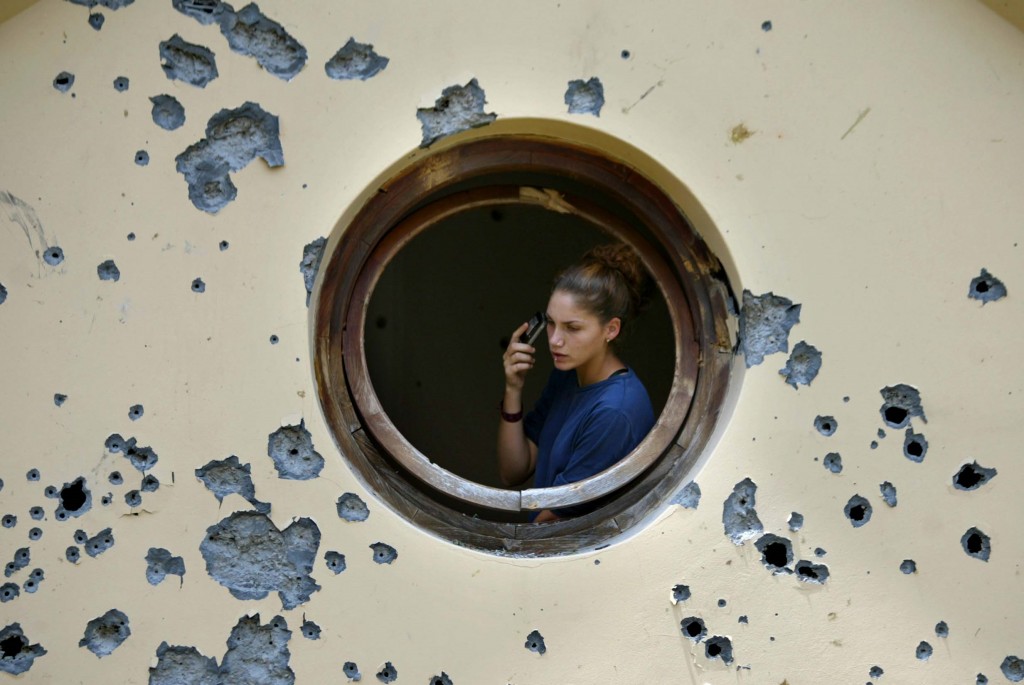
An Israeli woman checks the damage to her house after a Katyusha-style rocket attack in the northern Israeli town of Karmiel, July 15, 2006. Photo: Pierre Terdjman / Flash90
In fact, the Hanit returned to Ashdod Port on its own power, and despite Nasrallah’s boasts, the strike killed “only” four crewmembers. But the psychological victory was complete and turned Lebanese public opinion in favor of the war. It was Nasrallah’s finest hour. “We saw the flames on the sea and realized like everyone else that he had spoken the truth; not like other Arab leaders,” said a journalist, adding that it had created a “feeling of national pride in Hezbollah.” Israeli reaction was the opposite, dubbing the incident “a major disaster” and one of the most difficult events of the war.
In the end, a combination of poor military execution, increasing international pressure, and loss of domestic support forced Israel to halt the war. As Lebanese civilian casualties and destruction mounted without significant Israeli gains, the international community lost its patience. Israeli casualties—121 soldiers and 44 civilians—were light in comparison to previous Israeli military victories. But, without military progress, they created a perception of Israeli defeat. The IDF’s ground troops barely penetrated a few kilometers into Lebanese territory, and the IAF and Artillery Corps failed to silence the Katyushas, which continued falling until the ceasefire in order to send a clear signal that Hezbollah was still standing.
To win wars, regular armies must produce actual battlefield results—like conquering territory or decisively defeating their enemy—and cannot rely exclusively on psychological victories. Hezbollah may be able to achieve conventional victory when operating against irregular Syrian militias lacking Israel’s decades of military experience, but it will not be able to replicate that success against the IDF. The group simply lacks the manpower or budget to match Israel’s, either quantitatively or qualitatively, and is unlikely to continue enjoying Russian and Syrian air and artillery support in the next war.
Should it fight as a regular army, Hezbollah would be abandoning its guerrilla warfare advantages without enjoying the conventional strength to match Israel’s. Realizing this, Nasrallah recently said that “the resistance warfare method is the most useful and beneficial, the least costly, and we are still operating on this basis. We have not, at any time, initiated a classic war on such a large level. It was imposed upon us. What we prefer are resistance wars.”
It is unlikely that we will see columns of Hezbollah armor racing towards the Israeli frontier or a large-scale invasion of Israel. Nasrallah’s repeated threats since the start of the Syrian Civil War to conquer the Galilee must be treated with skepticism. In fact, in more sober moments, as recently as late last year, he has downplayed that threat as “hypothetical” and not a “definite” objective, saying that any such incursion would be limited. It is simply beyond the capabilities of a group with a maximum of 45,000 fighters (21,000 of whom are active) to mount a major invasion against a vastly larger and more powerful force. Beyond that, Hezbollah would be exposed on Israeli territory, where the IDF would possess the advantage. In all likelihood, a Galilee incursion would be another Hezbollah theatrical performance—a photo opportunity for its fighters to barely and briefly enter Israeli territory and plant their flag, with all of its attendant psychological effects on Israeli morale.
Moreover, operating as a conventional force would expose Hezbollah’s fighters and assets to IDF surveillance. The Israelis could then decimate Hezbollah’s fixed locations and forces, and cut its supply and communication lines with standoff aerial and artillery firepower, assets which Hezbollah lacks and against which it does not have effective countermeasures. Moreover, Hezbollah would lose the operational secrecy and opacity that have served it so well in the past. Secrecy not only protects Hezbollah from IDF attack, it also keeps the Israelis guessing. Nasrallah has stressed that Israel’s belief that Hezbollah possesses advanced capabilities—even if it actually does not—poses a challenge to Israeli military activities.
Hezbollah’s own preparations for its next war with Israel betray its intentions to once again act as a guerrilla force. Hezbollah has expanded and upgraded its already formidable underground tunnel network in south Lebanon. Replicating its strategy of using civilian cover, it has built up over 200 Shiite villages into fortified fighting zones, with rockets, anti-aircraft missiles, and command centers. Israel will be forced once again to choose between the unsavory options of striking the villages and killing civilians, or withholding fire. Despite rhetoric from the IDF brass that these areas will be considered targetable military bases, the Gideon Doctrine still acknowledges this as a real dilemma.
The weaponry Hezbollah has acquired in recent years also indicates that it is still adhering to the “rocket component” of its guerrilla doctrine. Its arsenal has grown in the decade since the Second Lebanon War to include 150,000 rockets. The majority are Katyushas, which are inaccurate and relatively ineffective. However, the emphasis on Katyushas is Hezbollah’s answer to the sophisticated multi-layer missile defense system Israel began developing in 2007, and which is now almost fully operational.

Police and medics inspects the site of a rocket attack by Hezbollah at the Haifa train station, July 16, 2006. Photo: Pierre Terdjman / Flash90
Lacking missiles advanced enough to bypass that system, Hezbollah likely intends to overwhelm it by sheer force of numbers. With Hezbollah expected to fire a daily average of 1,500 rockets in the next war, the cost of relying exclusively on missile interceptors would be prohibitive for Israel. Moreover, given the number of Hezbollah’s rockets, Israel’s defensive systems will not be able to intercept them all. Hundreds will likely strike the north, causing a similar disruption to civilian life and the economy as in the 2006 war. Because of their mobility and short battlefield exposure, they will again be difficult to stop with air or artillery power. The only option left to the Israelis would be sending troops into these villages, where Hezbollah possesses the defender’s advantage.
Hezbollah has no doubt gained invaluable experience in Syria, but it is still no match for Israel. The IDF is a far stronger force today than it was in 2006, and its forces have been training extensively to confront the challenges posed by Hezbollah’s guerrilla methods. Israel excels at short, sharp, and decisive operations—a traditional preference honed by its Gideon Doctrine. As a result, it will not be sufficient for Hezbollah to shorten the war, which promises to be more destructive than any previous confrontation between the two sides. To survive and claim another victory, the group must remain elusive to deny the IDF success on the ground or the ability to apply maximum force, even within that short time span. Meanwhile, it will aim to expose Lebanon’s populace and infrastructure to the IDF’s firepower. Given Hezbollah’s repeated successes in doing so as a guerrilla force, it would be self-defeating for the Party of God to change its strategy to one that would allow Israel to deal it a devastating blow.
![]()
Banner Photo: Helga Tawil Souri / flickr





